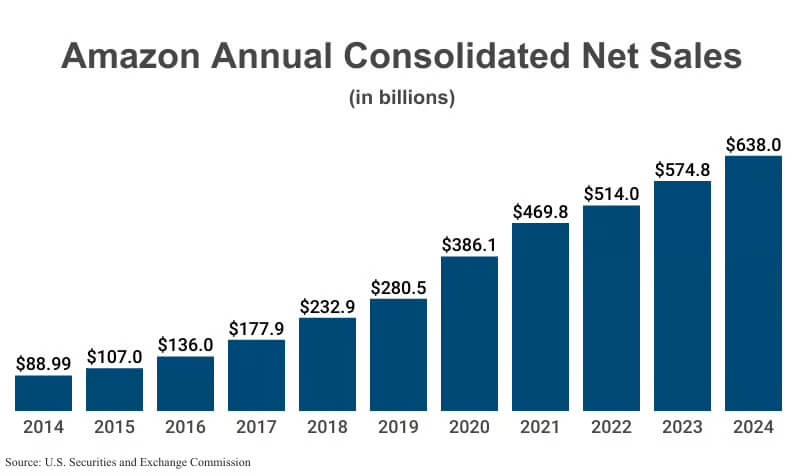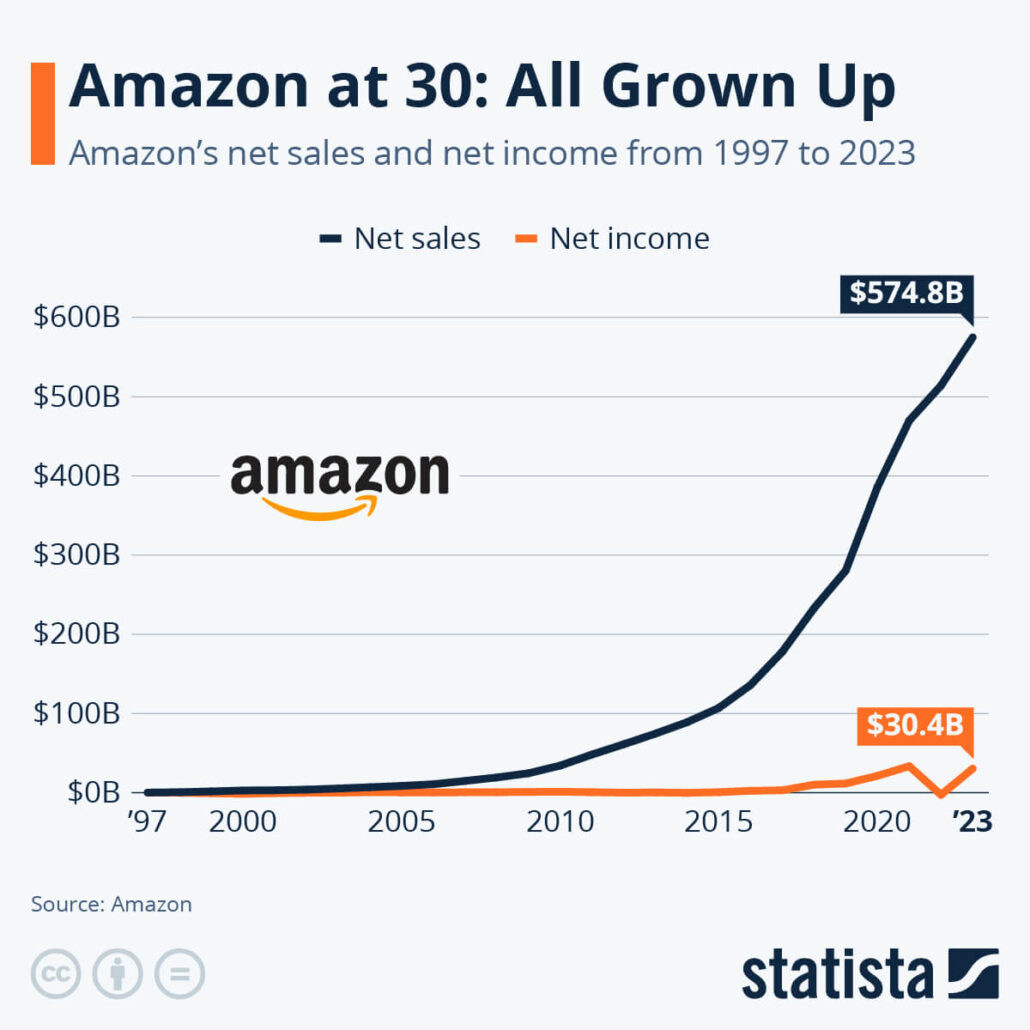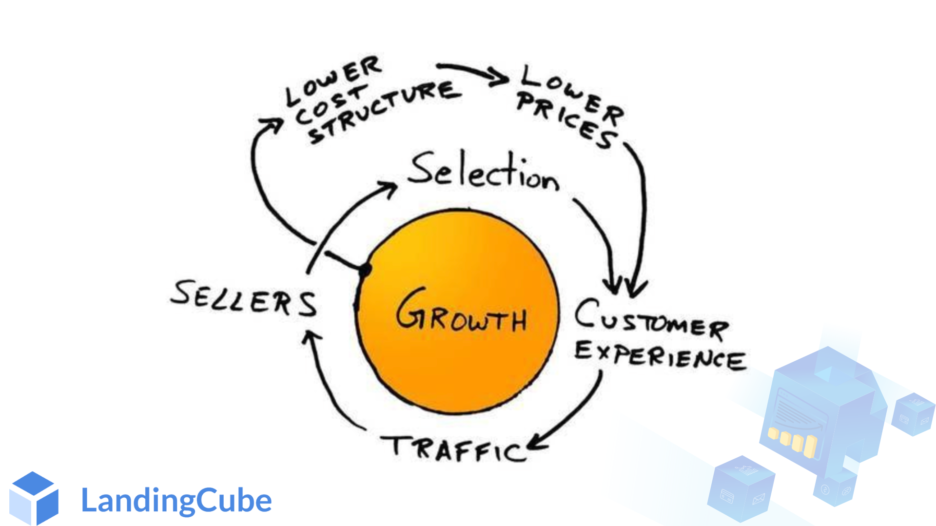The Amazon flywheel business model, also known as the Bezos flywheel is one of the most well-known models in modern business history.
It shouldn’t be any surprise, as Amazon is one of the most significant businesses we’ve seen, and certainly the biggest in the world today. Businesses like these don’t grow by accident.
We can learn a lot from the Amazon flywheel model, even if you’re a small brand without grand designs of becoming a trillion-dollar company. Read on to learn what it is, and how to apply it for your business.
Table of Contents
- What is the Amazon Flywheel Model?
- How the Amazon Flywheel Works
- The Impact of the Bezos Flywheel on Amazon’s Growth
- Is Amazon’s Flywheel Strategy Applicable for Small Sellers?
- How Third-Party Sellers Can Implement a Flywheel Business Model of Their Own
- The Customer Comes First
- Leverage Strategic Pricing to Accelerate the Flywheel
- Optimize Amazon SEO: Organic Search and the Amazon Flywheel
- Run an Effective Product Launch
- Set Up Evergreen Amazon PPC Advertising Campaigns
- Pro Tip: Generate External Traffic to Amazon Product Pages to Get Ahead
- Focus on Getting Great Reviews
- Widen Your Product Portfolio
- Reduce Overhead
- Final Thoughts: The Amazon Flywheel Really has Evolved into a Seller Flywheel
- FAQ: Amazon Flywheel What it is and How Sellers can Benefit from it
What is the Amazon Flywheel Model?
The Amazon flywheel is a business model that describes how Amazon created a virtuous growth cycle that helped it transform into one of the world’s largest companies. It forms the backbone for how Amazon grew into a company worth over a trillion dollars and it also summarizes how millions of Sellers grow their business on the Amazon platform.The Amazon flywheel started out as a sketch on a napkin, written by Jeff Bezos in a meeting with Jim Collins in 2000. That’s also why it’s often referred to as the Bezos flywheel. It plots out a plan for how Amazon was going to grow, using a few core principles that would feed off one another, creating a self-perpetuating flywheel.

The model illustrates the interconnectedness of the Amazon businesses and essentially summarizes how more Sellers list more products on the eCommerce marketplace, thereby creating more choice for consumers which in return enhances their shopping experience. This also creates price pressure, thereby attracting more shoppers which fuels growth for Amazon – and its partners the Sellers!
The model has been discussed ad nauseam in the years since, and is still a core part of the business today.
You can check out a video of it being broken down by Jeff Wilke, former Amazon Consumer CEO, here:
It’s also been coined the “Amazon Virtuous Cycle”. And its effectiveness is clear for anyone to see.
How the Amazon Flywheel Works
The Amazon flywheel is simple, and fairly self-explanatory from the napkin sketch.
Here’s a breakdown of each of the steps, and how they feed into each other and ultimately drive growth.
- The key focus is the Customer Experience. That’s the central point that the flywheel is built around.
- A positive customer experience leads to more customers, and a steady flow of Traffic.
- Traffic leads to a high demand for Sellers on the Amazon platform.
- More third-party sellers means a wide and diverse Selection for Amazon shoppers to choose from.
- That wide selection plays into the great Customer Experience, which keeps the flywheel moving.
Then there’s another offshoot that helps the flywheel keep moving:
- Amazon focused on building a business with a Lower Cost Structure.
- That means they can remain profitable while offering Lower Prices, which plays again into a great Customer Experience, perpetuating the rest of the flywheel.
Its simplicity shows you don’t need anything incredibly complex to build a successful business. All you need is a few simple principles, executed well.
The Impact of the Bezos Flywheel on Amazon’s Growth
It doesn’t take much analysis to see that the Amazon flywheel strategy has been successful for Amazon. Just look at where they are now. Amazon the company is more recognizable than the Amazon in South America (it’s a rainforest too, in case you didn’t know).
But Amazon’s trajectory of growth shows just how effective the flywheel has been, and how the flywheel business model has been the key driver for the company to get as big as it is today.
In 2000-2001, when the famous flywheel napkin meeting took place, Amazon was far from a big name. The business was pretty stagnant, actually.
Since they established the flywheel and set on their mission to constantly improve customer satisfaction, things really picked up. It took a few years to kick the flywheel into motion, but once it did, Amazon’s growth began to compound, and compound, to eventually become a company doing hundreds of billions of dollars in sales every year.


This trajectory is the crux of how a flywheel business model works. It’s not something that provides quick wins. A flywheel takes effort, work and investment to set up, and more to keep it moving in its early stages. But in time, when the flywheel starts moving, it drives itself and offers an incredible vehicle for growth.
Is Amazon’s Flywheel Strategy Applicable for Small Sellers?
The Amazon flywheel model has obviously been great for Jeff Bezos and Amazon. But what about the smaller third-party sellers out there? Those who don’t have any grand designs of becoming a billion or trillion-dollar company?
The great thing about the flywheel business model is that it works for all kinds of business. The principles are very simple, and while it might not work the exact same for you as it does for Amazon or another marketplace-type business, you can still take some pointers away to use on your own.
RANK LIKE THE PROS
Discover a better way to rank products from external traffic, like Facebook, Google and TikTok, with LandingCube promo pages.
Try it free for 21 days.
How Third-Party Sellers Can Implement a Flywheel Business Model of Their Own
Now for the practical side. How can you take away what we’ve learned from Amazon’s flywheel business model, and implement the same thing for your own business, as a third-party seller?
Obviously you need to tweak it a bit, as you’re not trying to follow the exact same blueprint. Your business is different to Jeff Bezos’ business in 2000, you have different goals, different challenges.
Here are some important principles and tips brands should take away from the Amazon flywheel.
The Customer Comes First
I believe this is the core of any business.
Without customers, you have no business. So they should be the most important part of your business. Everything should come back to the customer experience, and how you can produce happy customers.
This is particularly important for Amazon businesses, because it’s not just your customers you’re trying to please. They’re Amazon’s customers, first and foremost.
We’ve already seen that the customer experience is key for Amazon’s business model. So they’re going to favor sellers who also push this.
For any decision you make, bring it back to the customer. How does this affect the customer experience? Does it elevate it, or does it risk damaging the customer experience? For any 50-50 calls you have to make, think of what it means for the customer, and use that as the tiebreaker for any situation where you’re not sure what to do.
Leverage Strategic Pricing to Accelerate the Flywheel
Pricing is an important piece of the puzzle. It doesn’t matter how awesome your products are, or how impeccable your support team is, if you can’t offer competitive prices you don’t stand a chance on Amazon.
With regard to the Amazon flywheel, it is important that flywheel acceleration is based on unit sales, not dollar sales! That’s why it’s easier to kickstart the Amazon flywheel if you offer a product that sells for a lower price – in particular as compared to your competitors. Of course at the end of the day, other factors such as product quality and favorable reviews also matter, but make no mistake: in a blue ocean like Amazon.com, setting the right price is critical.
Optimize Amazon SEO: Organic Search and the Amazon Flywheel
SEO and constant Amazon listing optimization are pillars of building a flywheel for your brand, and indeed work as a flywheel on its own.
When you get your product to rank for relevant keywords, that starts delivering traffic and ultimately sales. Sales are a signal for the Amazon A9 algorithm and improve your organic search rankings – which then fuels further sales growth. And as bonus: More sales result in more customer reviews which (you may have guessed this) are also a ranking signal and typically improve your conversion rate. Generating sales thus benefits your rankings, and the two continue working off of each other.
That’s why Amazon SEO Strategy has to be your core focus as an Amazon seller. Getting this right makes it so much easier to build a sustainable store, and make sales without having to grind or pay for every customer.
Run an Effective Product Launch
An effective Amazon flywheel starts with your product launch. This is when you gain momentum that kicks the flywheel into motion.
Our guide has some tips on running an effective Amazon product launch, most of which can be thought of through the lens of the flywheel you’re trying to create.
You need strong SEO fundamentals, such as a good base of keywords to target and a high-quality product, which will form the structure of your flywheel. Then it’s the initial sales you drive that starts it moving. If you do everything else, the Amazon cycle will start working and sending you sales automatically.
Set Up Evergreen Amazon PPC Advertising Campaigns
Like Amazon, your flywheel will not lead to explosive growth straight away. Flywheels gather speed slowly, and need nurturing before you get to see the benefits of long-term, compounding growth. Investing in Amazon PPC advertising is one of the most cost effective ways to get the flywheel going. Simply bid in keywords that are a great fit for your listings to get them discovered by more shoppers on Amazon.com
Effective Amazon ads will drive sales and thereby help accelerate the Amazon flywheel.
Pro Tip: Generate External Traffic to Amazon Product Pages to Get Ahead
You can do things during the early stages of your flywheel strategy to keep it moving (how to increase Amazon sales) and keep momentum going. External traffic via Google Ads or Meta Ads are one way of accomplishing this goal. They help provide a steady increase in sales (HOW TO INCREASE AMAZON SALES) and keep the momentum going.
Also, evergreen external traffic campaigns are a great supplement for organic sales. Google Adwords for example, you can set up and run on autopilot, delivering a constant flow of sales, along with the positive ranking effect of external traffic.
Learn more here about running Google Ads for Amazon products. And for help running profitable PPC campaigns, check out SellerMetrics, who have the industry-leading PPC management software, as well as a managed PPC service that can help you out.
Focus on Getting Great Reviews
Reviews are another key part of the flywheel process. The more positive reviews you get, the better your product looks to future customers, and the more opportunities you have to get reviews.
Reviews are also a sign that you’re providing a great customer experience, again one of the most important parts of the Amazon flywheel model.
RANK LIKE THE PROS
Discover a better way to rank products from external traffic, like Facebook, Google and TikTok, with LandingCube promo pages.
Try it free for 21 days.
Learn More: the best ways to get reviews on Amazon today.
Widen Your Product Portfolio
A wide selection of products is one of the core parts of the Amazon flywheel. They wanted to be known as the “everything store”, where shoppers go to find literally anything they need to buy (at low prices).
You don’t need to do exactly the same thing, but adding to your range can have certain benefits, creating a kind of virtuous cycle in itself.
Selling a range of complementary products gives you the opportunity to earn more from each customer. If someone comes to you for one thing, you can cross-sell or up-sell something else.
Regularly up-selling increases the value of each customer, meaning you may be able to justify lower prices to attract customers. It also builds customer loyalty, which is another powerful flywheel once cultivated.
Reduce Overhead
Like with Amazon, if you can spend less in expenses and overhead, you can afford to offer lower prices and have a competitive advantage.
There are plenty of ways to do this. You can find better suppliers, or negotiate better rates with your current suppliers. You can manage inventory more efficiently and increase cash flow.
AI also offers a ton of ways to make your business run more efficiently with less overhead. All in all, you don’t need to completely flip your operating model on its head, but small changes can give you a small edge that you can use, as Amazon did, to get an edge in the customer experience.
Final Thoughts: The Amazon Flywheel Really has Evolved into a Seller Flywheel
Amazon is a great case study for any business to learn from. It’s one of the most successful companies in human history. And much of its success is down to the impact of one little diagram sketched on a napkin.
Amazon sellers can utilize a similar approach to the Amazon flywheel strategy. At the center of everything, dedicate yourself to excellent customer service. Higher customer satisfaction drives more sales, which allows you to double down your efforts to generate traffic, and invest in the flywheel of Amazon SEO.
There are many short-term hacks in Amazon selling, but concentrating your efforts on being a customer-centric company is a long-term play that has proven itself time and time again to be a winning move.
FAQ: Amazon Flywheel What it is and How Sellers can Benefit from it
The Amazon Flywheel is a self-reinforcing business model that drives growth through customer satisfaction. Introduced by Jeff Bezos, it describes how key elements—such as low prices, wide selection, and fast delivery—work together to attract more customers, increase sales volume, and lower costs, creating a cycle of continuous momentum.
For sellers, the Flywheel means that actions like optimizing listings, running ads, and earning good reviews don’t just boost one metric—they strengthen the entire system. More traffic leads to more conversions, which leads to more reviews, better organic ranking, and higher profitability. Each improvement spins the Flywheel faster.
The core components for sellers include:
Product visibility (traffic)
Conversion rate optimization
Customer satisfaction (reviews, delivery, service)
Pricing strategy and selection
Together, these elements fuel one another and accelerate your brand’s growth on Amazon.
Because Amazon’s ecosystem is built to reward performance. The more you sell and satisfy customers, the more visibility you get (through organic rank and ad performance), which brings more sales. Unlike linear growth models, the Flywheel scales exponentially once momentum is built.
Start by focusing on:
Optimizing your product listings (titles, bullets, A+ content)
Running high-ROI Amazon PPC campaigns
Encouraging verified reviews
Monitoring and improving your seller metrics (e.g., shipping, customer service)
Offering competitive pricing and bundling options
Consistency across these areas creates the positive feedback loop that powers the Flywheel.
Absolutely. Amazon Sponsored Ads (like Sponsored Products and Sponsored Brands) play a critical role in initiating the Flywheel. Ads drive initial traffic and sales, which help boost your organic rank and review velocity—fueling long-term momentum.
Yes—but it takes intentional effort. New sellers can kickstart the Flywheel by launching with aggressive advertising, offering competitive pricing, enrolling in FBA, and focusing on customer service to quickly build trust and reviews.
It depends on your category, competition, and execution. Some sellers may see momentum within weeks, while others need several months of consistent effort. The key is to focus on all parts of the Flywheel—traffic, conversions, reviews, and customer satisfaction—for sustainable growth.
Neglecting listing optimization
Underinvesting in ads
Ignoring customer feedback or negative reviews
Using poor-quality images or vague copy
Not monitoring key metrics like TACoS or Buy Box win rate
These missteps can slow or completely stall your Flywheel’s momentum.
Amazon’s ranking algorithm rewards listings that perform well—those with high CTRs, strong conversion rates, and customer satisfaction. The Flywheel feeds this algorithm by continuously improving these signals. The better your performance, the higher you rank, the more traffic you get—and the cycle continues.
RANK LIKE THE PROS
Discover a better way to rank products from external traffic, like Facebook, Google and TikTok, with LandingCube promo pages.
Try it free for 21 days.



